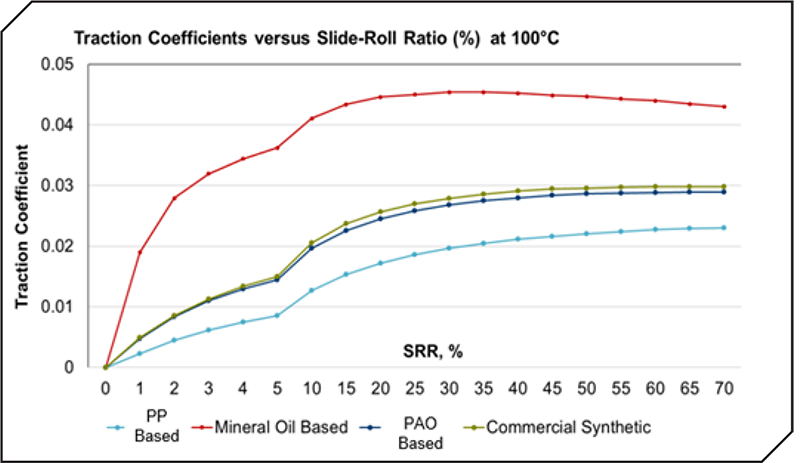
Shubhamita Basu, Ph.D., North America Product Manager, Industrial Oils and Carlos Nazario, North America Product Manager, Grease Additives

Figure 1 Traction Coefficient
Companies that depend on industrial enclosed gears and open-gear systems are always searching for the best way to keep those systems lubricated while keeping the oil cooler. Higher operating temperatures can be detrimental for the quality of oil which can, in turn, cause gearbox durability issues. Reducing temperatures while maintaining adequate protection is paramount, as these gears are part of intricate operations that can cost significant time and money should they wear down or break.
While mineral oil-based fluids used to be the standard, operators are increasingly looking for the better protection offered by synthetic oils using Polyalphaolefin (PAO)-based formulations. PAO-based oils do perform well in these heavy-duty applications, but they can be significantly more expensive than their mineral oil counterparts. For lubricant manufacturers, the challenge is to create synthetic industrial gear oils (IGOs) and open gear lubricants (OGLs) that can offer the appropriate protection while keeping costs reasonable. Tests performed on lubricants with
performance polymers (PPs) have shown their ability to achieve both of those goals. In this article, we will examine the history of IGOs and OGLs, what a PP is, how lubricants with PPs perform under real-world conditions and what advantages they provide for IGO and OGL end users.
The History of Industrial Gear Oils and Open Gear Lubricants Both IGOs and OGLs have undergone significant changes over the past 50 years. Engineering advancement has led to the development of much smaller enclosed gearboxes that are capable of producing higher power throughput compared to their mammoth forebears. These compact and more powerful gearboxes need a much smaller volume of IGOs leading to incomparable stress on the oil.
OGLs have also evolved significantly. Historically, OGLs were made of asphaltic bases without significant additive treatments, and there was no differentiation for OGLs based on end usage. Over time, OGLs have become more complex as scientists began to recognize that different open gear applications required different types of lubricants.
To address the shortcomings of conventional IGOs and OGLs in mineral oils, synthetic formulations are typically used. Using PPs can lead to the development of a new way to formulate synthetic IGOs and OGLs. In both cases, new and improved PPs offer specific advantages over traditional formulations.

Figure 2 Temperature reduction by worm gear
PPs are a versatile class of polymers with unique architecture that offer superior thickening efficiencies, low traction coefficients and high shear stability. Depending on the end use applications, PPs can be used both as viscosity modifiers as well as base oils. They also exhibit excellent thermal and oxidative stability and can be used in incidental food contact applications and are NSF HX-1 certified.
The versatile nature of PPs allows them to be used with PAO base oils as well as with mineral oils. When added to more conventional base oils, PPs can elevate the performance of the resulting fluids by lowering the traction coefficients and operating temperatures while increasing overall energy efficiency—and these advantages are demonstrated in extensive statistically validated laboratory testing.
One of the greatest threats to industrial gear systems is the high temperatures under which they operate. After all, higher operating temperatures can cause durability issues and lead to poor film thickness in many applications. The goal of the laboratory test was to determine whether PPs could reduce temperatures enough to protect bearings while preventing micropitting and white etching cracks.
In the laboratory, four different fluids were tested:
• Mineral oil-based IGO.
• Commercial synthetic oil.
• Synthetic IGO with heavier PAO in PAO base oil.
• Synthetic IGO with a PP in PAO base oil.
Mineral oil-based IGO and the commercial IGO were the poor and good reference oils used in the study. Both of the test fluids—PP-based and conventional synthetic with heavier PAO—used the same performance IGO additive at 1.8% weight.
The four fluids were tested to measure their traction coefficients, temperature reduction and energy efficiency.
Temperature reduction was measured using an in-house worm gear efficiency rig as well as an FZG rig.
The charts above showcase that IGOs formulated with PPs can demonstrate lower traction coefficient compared to even standard PAO-based synthetic IGO, which can reduce the gearbox operating temperature significantly. Temperature reduction by the FZG rig shows that IGO formulated with PP runs 17 C cooler compared to conventional mineral oil-based formula.
PPs can be used with Group III base oil to generate performance similar to or slightly better than conventional PAO-based synthetic IGO, and this offers a more cost-effective way of formulating synthetic IGOs.
The results of those tests (seen in the illustrations below) reveal that PPs perform equally well in the less expensive oil as a base. This means that IGOs with PPs can offer the same protection as the more expensive PAO-based synthetics and can provide a cost-effective alternative.

Figure 3 Temperature reduction by FZG rig shows that IGO formulated with PP runs 17 °C cooler compared to conventional mineral oilbased formula.

Figure 4 Gr III Synthetic with PP vs. PAO Synthetic.

Figure 5 Viscosity of Lubrizol’s OGLs with PP technology at different temperatures
Open gears can range in size and be up to 90 feet in diameter. They take 12 months to manufacture and cost nearly $1 million, so keeping them in appropriate working order is paramount. OGLs must be designed for boundary and mixed lubrication as well as high viscosity for full-film lubrication.
To see how PPs perform in OGLs in the real world, three different fluids were tested:
• Grease-type OGLs.
• HV PIB-mineral type OGL.
• Fluids formulated with PPs.

Figure 6 Residual pressure at lowest testing temperature.
A basic performance test was performed on the fluids to determine the kinematic viscosity at different temperatures, low temperature fluidity or pumpability, theorical film thickness in typical gear sets at operational temperatures, temperature reduction and energy efficiency.
The results (seen in the illustrations above) reveal that OGLs with PPs provide superior lubricant film thickness at initial and operational temperatures that are lower than their more traditional counterparts. These factors improve the overall performance of the OGL and provide more protection for the systems in which they are used.

Figure 7 Comparing different OGL tiers film thickness at typical operational temperature.
Synthetic IGOs formulated with PP as the viscosity modifier can offer reduced operating temperature, higher energy efficiency and low traction coefficient while reducing the total formulation cost by 20%-40% compared to a conventional synthetic formula. This newer formulation approach can extend oil drain interval and offer a more sustainable solution to IGO development.
In OGL, the performance polymer provides versatility as a base fluid. It also provides improved performance characteristics to OGL used in the mining, cement and sugar cane industries. Finally, it provides product sustainability, as well as reduces lubricant consumption and energy usage.
For more information on industrial gear oils, open gear lubricants and performance polymer technology, please contact your Lubrizol representative.

Figure 8 Lubrizol OGLs with PP technology shows better performance in temperature reduction in FZG rig.

Figure 9 Significant temperature reduction between general market mineral OGL and Lubrizol OGL with PP technology

Figure 10 Lubrizol OGL with PP technology shows better performance in energy consumption in FZG rig
 Dr. Shubhamita Basu is the North America Product Manager for Industrial Oils at Lubrizol, where she manages the hydraulic fluid, industrial gear oil and turbine oil portfolio. Dr. Basu has worked extensively in developing new molecules, engine oils and limited slip-gear oil applications, as well as formulating hydraulic fluid and industrial gear oils. She has also led an energy efficiency initiative and spearheaded environmentally acceptable lubricant development.
Dr. Shubhamita Basu is the North America Product Manager for Industrial Oils at Lubrizol, where she manages the hydraulic fluid, industrial gear oil and turbine oil portfolio. Dr. Basu has worked extensively in developing new molecules, engine oils and limited slip-gear oil applications, as well as formulating hydraulic fluid and industrial gear oils. She has also led an energy efficiency initiative and spearheaded environmentally acceptable lubricant development.
 Carlos Nazario is the North America product manager of Grease Additives for Lubrizol. He has worked extensively in developing and applying new lubricants for heavy-duty equipment and has formulated specialized extreme-pressure greases and gear oils, open-gear lubricants and energy-efficient and environmentally acceptable lubricants for heavy-duty equipment.
Carlos Nazario is the North America product manager of Grease Additives for Lubrizol. He has worked extensively in developing and applying new lubricants for heavy-duty equipment and has formulated specialized extreme-pressure greases and gear oils, open-gear lubricants and energy-efficient and environmentally acceptable lubricants for heavy-duty equipment.